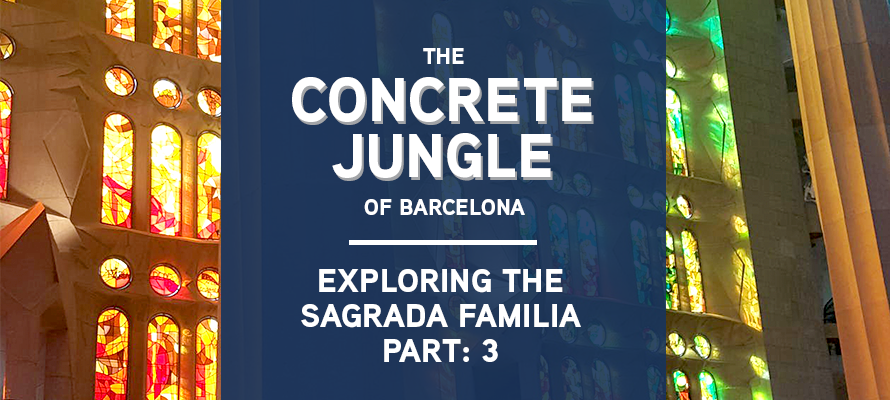
When I first stepped foot inside the Sagrada Familia almost four years ago I was more than a little offended when a fellow art student commented that this iconic structure was “ugly.” In last week’s article, I explored the two completed facades and how they encapsulate the fullness and depth of the Catholic faith. If you have yet to discover the outer beauty of this impressive vessel, I invite you to start with the first few parts of this series:
Part 1: The Concrete Jungle of Barcelona: Exploring the Sagrada Familia Part 1
Part 2: The Concrete Jungle of Barcelona: Exploring the Sagrada Familia Part 2
Come On In
We’ve spent a lot of time outside; I think it’s about time that we go inside for a bit. Because the main façade of the basilica isn’t completed yet, most guests will enter through the Nativity façade. As you walk inside the side door, you journey through a forest of columns that seem to continue into the sky forever. As they grow upwards, the columns branch off into smaller columns, like huge sequoias that merge into umbrella treetops and join together to create the ceiling. Interspersed throughout the vaulted ceiling are scattered skylights that shine through the forest of columns onto the visitors below. Gaudi intentionally set out to reflect nature and its shapes in the interior because he believed that one could encounter God and His beauty more closely when immersed in nature. You’d be hard-pressed to find straight lines, 90 degree angles, or traditional design within this sacred space.
When Gaudi was planning his masterpiece, he wanted the light from the outside to complement the structures that were present within. The whole building is covered in stained glass windows that are speckled with colors. When the sun shines through them, they paint the stonework inside a chorus of different shades. Resting right in that glow and wrapped around the top half of the nave sits a grand choir loft that seats over 1000 singers. The balcony winds around the three sides of the basilica, curving around the tree-pillars that are supporting it.



The Apse
At the very front of the basilica is the apse. It’s fairly simple; there isn’t a whole lot going on (quite honestly, I’m not a fan). In more traditional churches, this sacred space seems to be the most visually interesting part and focal point of the architecture because it keeps our attention during the highest parts of the Mass. But really it’s quite simple in the Sagrada Familia. There’s a simple altar that’s shaded by a suspended crucifix and the entire thing is fit into a rising tower that is crowned with a large skylight. In my humble opinion (which is very humble, I went to art school, not architecture or theology school), this altar doesn’t live up to the standard established by the rest of architecture throughout the basilica. But, considering the finish-date of the basilica is still at least ten years into the future, there is still some time for improvement.
One aspect of this interior that would instantly strike most Catholics is that – aside from three solitary statues of Jesus, Mary, and Joseph that guard each entrance, and the crucifix affixed above the altar – there is absolutely no religious imagery in the interior of the basilica. Even without these reminders of Christ and the story of His Church, I was on the verge of tears as I stepped inside.



How Great Thou Art
Walking into this space you feel small. As a human that barely reaches the 5’00” mark on the measuring stick, I’m used to this sensation, but in this vast space I also felt the smallness of humanity. I was more fully aware of the largeness of our God, the greatness of his power, and the vastness of his love. As I walked through this literal concrete jungle, I remember not being able to comprehend how man had been able to construct something so marvelous. How much greater is our God, then? He’s the Creator of the creators, the Creator of creation, the Creator who seeks after us in our smallness.
For me, that was the greatest takeaway from this historic and grand site – the way in which it seemed to reflect the very being of God, his humility through his incarnation in the Nativity, his abundant love in the events of His passion, and his incredible greatness ever-present in creation here on earth.
Interested in actually visiting the Sagrada Familia? Join us on one of our upcoming pilgrimages to the Marian Shrines of Europe!



